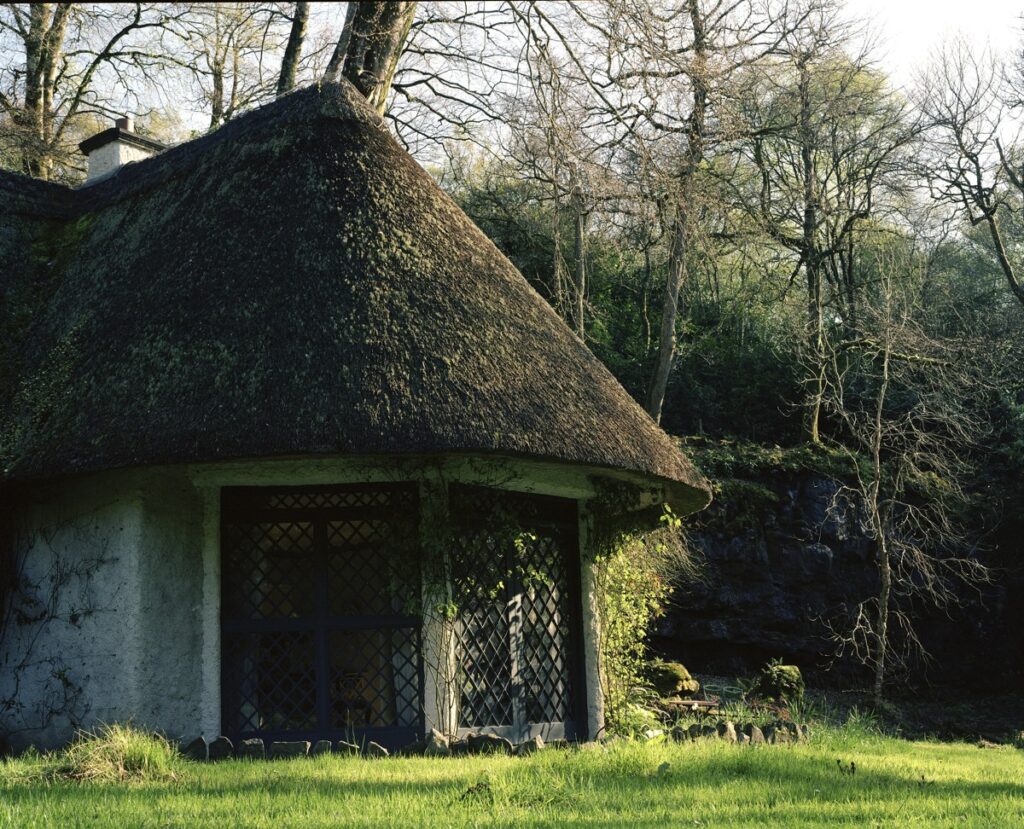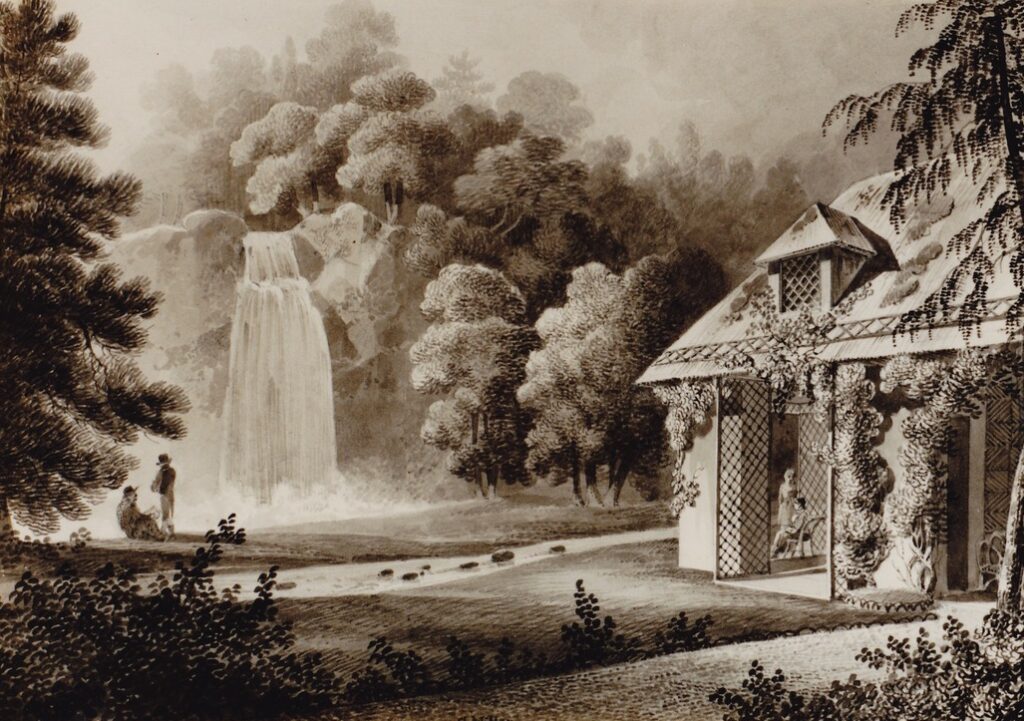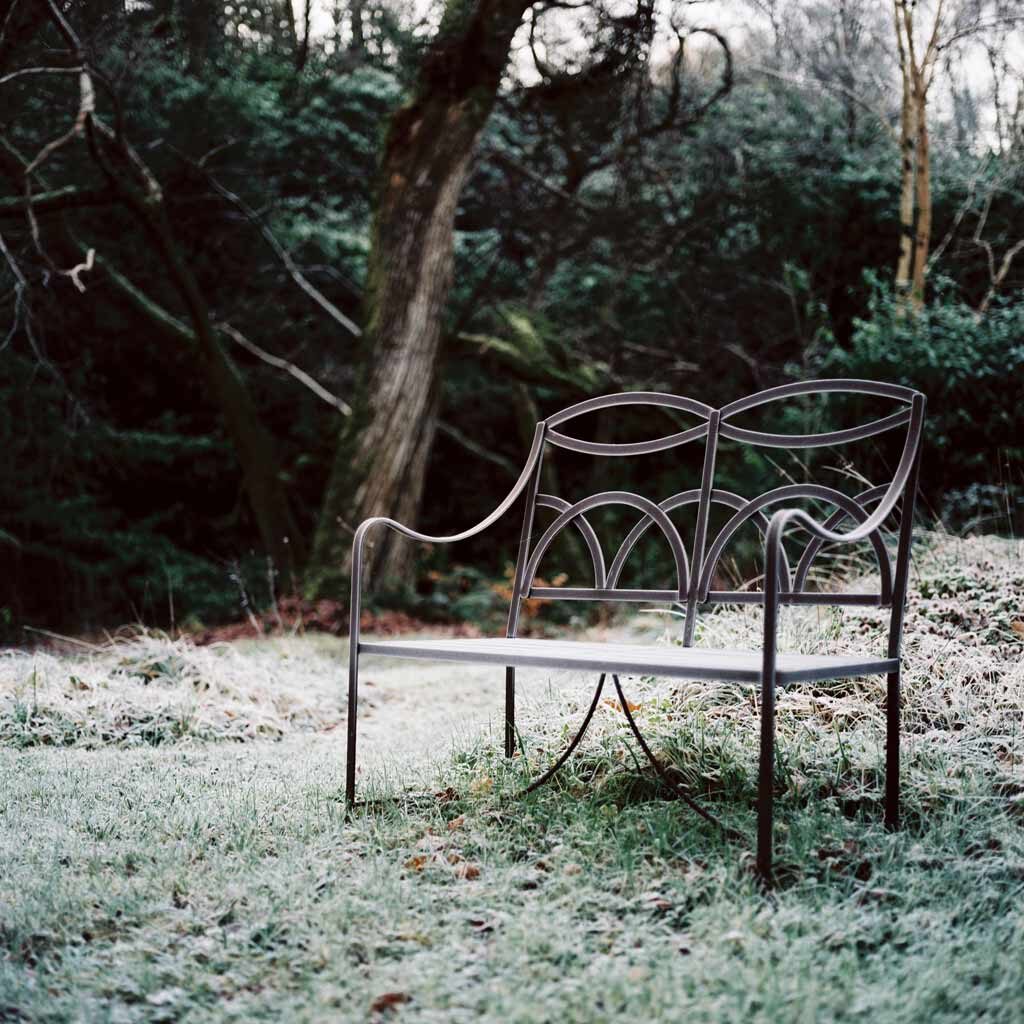A ROMANTIC LANDSCAPE within the demesne of Kilfane House was developed during the 1790’s by a particularly cultured and sensitive landowner and his wife, Sir John and Lady Power. Sir Richard Power, twin brother of Sir John also joined in the development of the garden. The family were leaders of intellectual society within the southeast of Ireland during this period, founding the Kilkenny Theatre, a venture with far reaching influence within the area. They amassed a notable collection of books, one of the most important libraries within the country, and their estate and mansion were, at the turn of the 18th and during the 19th centuries, models of the most modern taste and advanced design.

Under the influence of Rousseau and the Romantic movement, a trend had begun in the final days of the 18th century for the improvement of parks, demesnes and gardens in a new style: more rugged and wild, expressionistic landscapes became the preferred mode, away from the earlier arcadian, pastoral, sublime fashions of the early 18th century. The use of water (cascades and waterfalls) for most dramatic effect, the exploitation of more savage and withdrawn places (ravines and valleys), and the introduction of architectural caprices (caves and grottoes), combined to create and heighten a series of picturesque scenes which might embody the perfect Romantic attitude and transport the soul in a sweet and tender melancholy.
In the Kilfane estate, a most apt and appropriate location for this exercise was presented by a ravine on the edge of the demesne. This piece of ground is shown on the 1795 estate map, immediately before the Powers commenced work, as a woodland of beech, sweet chestnut, oak, larch and Scots pine. The ground involved under ten acres in all (excluding the 1 mile long overland water canal), making the undertaking attractive and affordable for a minor landlord of limited resources. The dramatic and natural features of the place presented an unequalled opportunity for the creation of a secluded landscape: a tumbling and cascading stream winds through a narrow valley floor, surrounded by sheer rock faces and outcrops, 30 to 50 feet high, and slanting drops strewn with boulders.
The principle elements introduced to this natural setting by the Powers and their landscape designer (whose identity is at present unknown) was a dramatic waterfall, made by diverting water from the stream before it entered the ravine and conducting it along a small canal or feeder channel over one mile before emerging to fall over a rocky cliff 30 feet high. From the pool at the base of the cliff, a small water course runs to join the main stream close by, which at this point flows through a grassy lawn at the centre of the glen. Adjoining the waterfall a few yards to the west, a rustic grotto was created at the base of the cliff. One approach to the ravine was by a stone stairway, winding down the cliff and egressing through the grotto. In this, the parallel with the renowned Romantic garden and grotto of the Naiads and the cascade created at Ermenonville by Rene Girardin, and described by him in “Promenade ou itineraire des jardins d’Ermenonville” (1788) is remarkable.
On the opposite side of the main stream, facing the grotto and waterfall sits a thatched summerhouse or cottage orne, a resting place for visitors. Surrounded by a grassy clearing, the cottage allows the fullest contemplation, enjoyment and participation in the wild and savage scene, which had been so artfully contrived. A series of meandering paths by the stream and up the step sloping side of the ravine gave ample scope for walks and the creation of a series of enchanting tableaux and pictures. Rustic seats, bridges across the water, and features such as a well or fountain at the foot of the cliff, provided additional interest for visitors.
That this venue was resorted to by many visitors in the early years of the 19th century is evidenced also by a letter by Louisa Beaufort in 1819.

“Wednesday Mr. B, Pa Ma and I in the inside jaunting car and Richard on horseback all went to Kilfayne, Mr. Power’s, a very pretty place, …we were to walk to a cottage on the mountain side, having no notion of the length of the way, my father set out, he got on beautifully for some time, but his tormenting heart made him pause; we ladies went on and Richard stayed with my father and was most kind and good natured and patient, talking and beguiling the way …All the beginning of the walk very ugly, latter part very pretty by a stream …rushing over large beds of rocks, the beeches high and well planted and the ground blue with harebells the cottage is prettyish, somewhat of a has-been but stands in a tiny lawn near the stream and opposite to a cataract which rushes down the opposite rock — …Mr. Butler and I scrambled up and down every rock and bank and had much amusement…” Louisa Beaufort to Sophy Edgeworth, 1819

The survival of a series of sketches and watercolours of the principal features in this landscape, i.e., the cottage, the waterfall and surrounding woodlands, gives a clear view of the place as it existed in 1805. From the above description, it is clear that the planting was completely in keeping with the wooded setting and was contrived to heighten the natural rustic atmosphere. The introduced shrubs, apart from those mentioned, were large scale plantings of prunus laurescerus and the then highly fashionable and newly available rhododendron ponticum. The subsequent (post 1830) spread of laurel and rhododendron and the consequent loss of light at ground level, eliminated most of the ancillary plantings. In a few areas, patches of woodland plants (bluebell, campanula, wood anemones and ferns) survived, indicating that they must have formed a most significant feature in the initial stages.

A contemporary and neighbouring undertaking, so similar as to suggest the hand of the same designer, was created in the Woodstock Demesne, seat of the Tighe family in Co. Kilkenny. However, neither there nor at Belview in Co. Wicklow (where another rustic cottage orne is known to have existed) was the intense sense of drama, seclusion and enclosure in the highly charged and remarkably intimate setting achieved.
The death of the creators of the place and indeed the changing fashions in Ireland at the time caused the abandonment of the glen and fortunes of this fragile creation quickly waned. In a short time, the cottage fell into ruin, paths were lost under scrub, the waterfall dried up as the feeder canal was breached and broken and the cave collapsed.
Fortunately, the siting at the edge of the demesne or park, well away from subsequent 19th and early 20th century domestic and agricultural activities, ensured that the dilapidated site was not meddled nor interfered with, so that now this very compact and most articulate and Romantic concept, – the very finest in the country, – is being rescued and conserved in an absolutely strict and truthful manner.
